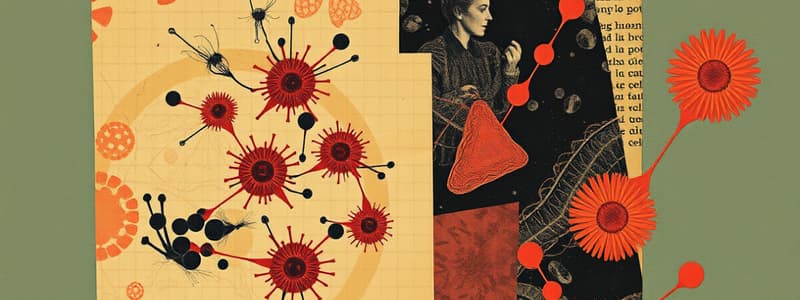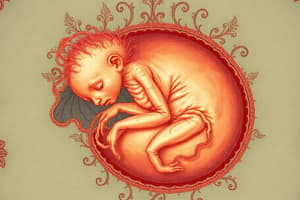Podcast
Questions and Answers
Which type of cartilage is characterized by the presence of only collagen fibers in its matrix?
Which type of cartilage is characterized by the presence of only collagen fibers in its matrix?
- Articular cartilage
- Hyaline cartilage (correct)
- Elastic cartilage
- Fibrocartilage
What is the primary role of chondrocytes in cartilage?
What is the primary role of chondrocytes in cartilage?
- To repair damaged cartilage
- To produce the cartilage matrix
- To initiate cartilage growth
- To maintain the cartilage matrix (correct)
Which growth mechanism involves the production of daughter cells within a single lacuna?
Which growth mechanism involves the production of daughter cells within a single lacuna?
- Appositional growth
- Extracellular growth
- Interstitial growth (correct)
- Metaplasia growth
What is a significant reason for cartilage's slow repair process compared to bone?
What is a significant reason for cartilage's slow repair process compared to bone?
What function does bone primarily serve in the body?
What function does bone primarily serve in the body?
Which of the following statements about cartilage is true?
Which of the following statements about cartilage is true?
Which statement about the structure of bone is correct?
Which statement about the structure of bone is correct?
What distinguishes appositional growth from interstitial growth in cartilage?
What distinguishes appositional growth from interstitial growth in cartilage?
What is a primary characteristic of cartilage?
What is a primary characteristic of cartilage?
Which layer of tissue lies beneath the epidermis and dermis?
Which layer of tissue lies beneath the epidermis and dermis?
How are somites related to the central nervous system?
How are somites related to the central nervous system?
Which type of tissue is primarily involved in repairing connective tissue?
Which type of tissue is primarily involved in repairing connective tissue?
Which statement best describes the function of fibroblasts?
Which statement best describes the function of fibroblasts?
What is true about the vascularity of cartilage?
What is true about the vascularity of cartilage?
Which of the following best describes adipose connective tissue?
Which of the following best describes adipose connective tissue?
What is the role of cartilage in the skeletal system?
What is the role of cartilage in the skeletal system?
What is the main characteristic of intramembranous ossification?
What is the main characteristic of intramembranous ossification?
Which of the following structures is primarily formed by intramembranous ossification?
Which of the following structures is primarily formed by intramembranous ossification?
What type of growth do osteoblasts facilitate in bone formation?
What type of growth do osteoblasts facilitate in bone formation?
What function do osteoclasts serve in bone physiology?
What function do osteoclasts serve in bone physiology?
Which structure is created by the action of osteoclasts during bone resorption?
Which structure is created by the action of osteoclasts during bone resorption?
What anatomical feature gives skeletal muscles their striated appearance?
What anatomical feature gives skeletal muscles their striated appearance?
Which of the following statements regarding myofibers is correct?
Which of the following statements regarding myofibers is correct?
How do osteocytes contribute to bone health?
How do osteocytes contribute to bone health?
Flashcards are hidden until you start studying
Study Notes
Somites and Connective Tissue
- Somites are structures found on the sides of the developing central nervous system, playing a crucial role in embryonic development.
- Fibroblasts are specialized cells essential for forming connective tissue, providing structural support within the body.
Types of Connective Tissues
- The innermost layer of tissue lies beneath the epidermis and dermis, contributing to the body's structural integrity.
- Adipose connective tissue, composed of fat, is located beneath the skin, around organs, at joints, and in the oral cavity, serving as an energy reserve and insulator.
Characteristics of Cartilage
- Cartilage is a firm, nonmineralized connective tissue that acts as skeletal support in the body.
- Chondroblasts, found internal to the perichondrium, are responsible for producing the cartilage matrix, while mature chondrocytes maintain this matrix.
- Hyaline cartilage, the most common form, comprises only collagen fibers within its matrix.
Growth of Cartilage
- Cartilage grows through interstitial and appositional methods. Interstitial growth occurs from deep within the tissue, with chondrocytes undergoing mitosis and secreting more matrix, expanding tissue size.
- Cartilage has no blood supply, resulting in slower repair compared to vascularized bone, and contains no nerves, minimizing pain from injury or surgery.
Overview of Bone
- Bone is a rigid connective tissue forming the majority of the mature skeleton, providing protection and structural support for soft tissues and serving as an attachment mechanism for muscles.
- Intramembranous ossification involves the formation of osteoid between two sheets of dense connective tissue, which replaces outer connective tissue, influencing structures like the maxilla and mandible.
Bone Growth and Remodeling
- Appositional growth occurs through layered formation along the bone's periphery, facilitated by osteoblasts, which later become osteocytes embedded within the bone.
- Osteoclasts are specialized, large multinucleated cells responsible for bone resorption, found on secondary bone surfaces within pits called Howship lacunae.
Muscle Tissue
- Skeletal muscles, also known as striated muscles, exhibit a striped appearance microscopically due to their structure.
- Each skeletal muscle comprises numerous bundles of muscle fibers, or myofibers, organized into fascicles, allowing for coordinated movement.
Studying That Suits You
Use AI to generate personalized quizzes and flashcards to suit your learning preferences.




